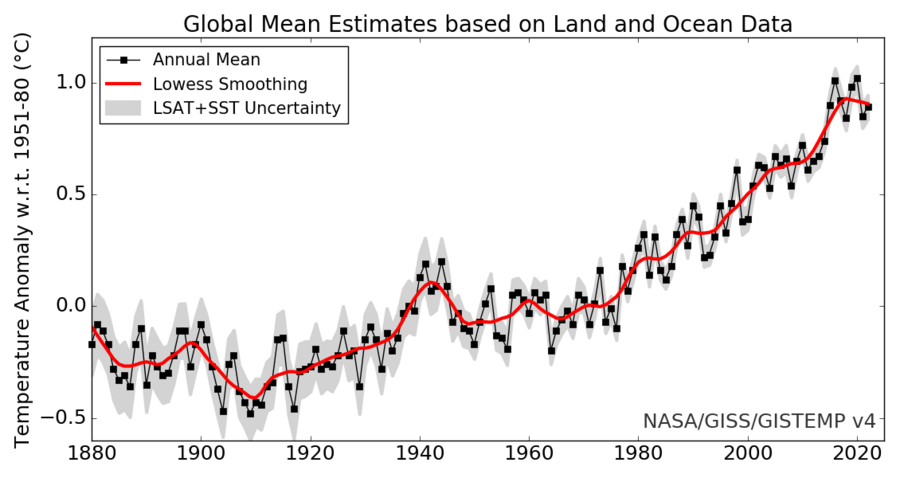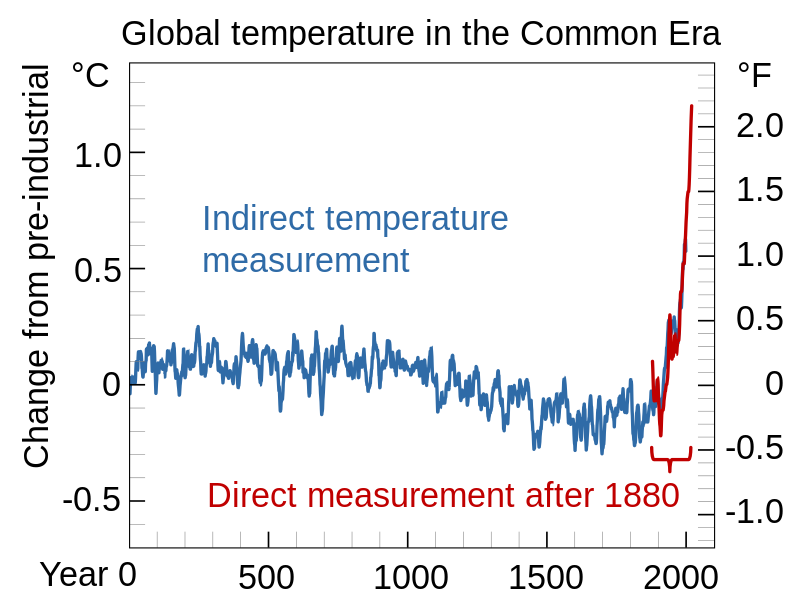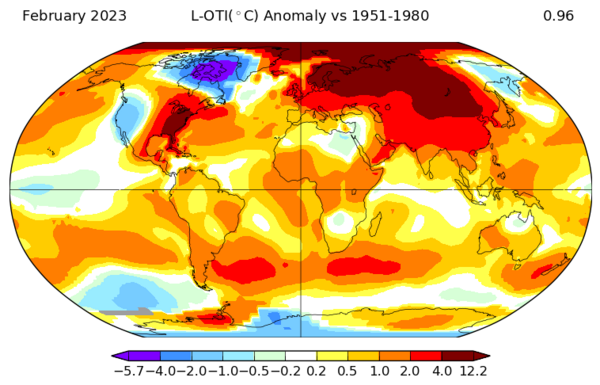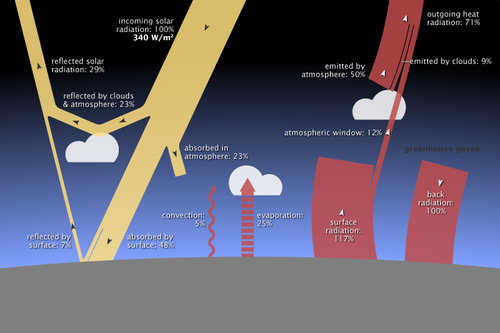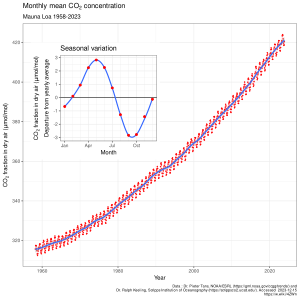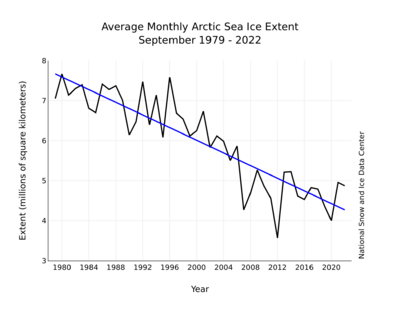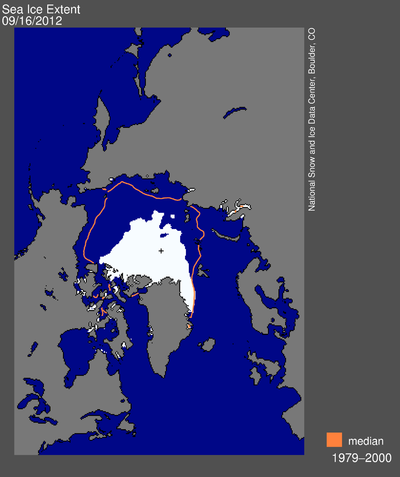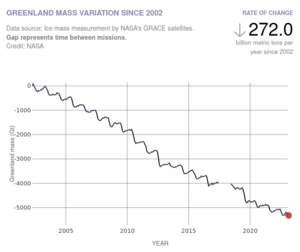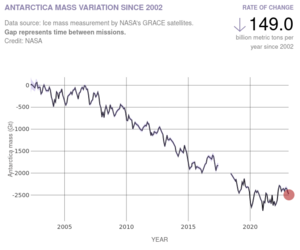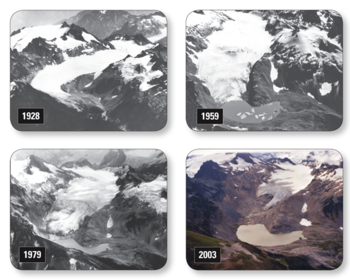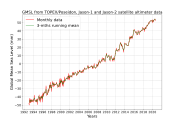Global Warming
| Environmental Science | |
|---|---|
| Topics | What is the Environment | Planetary Boundaries | Ecological Footprint and Sustainable Development | Food and Agriculture | Population | Ecology - Definitions and Outline | Energy Flow in Ecosystems | Population and Community Ecology | Material Cycles | Biodiversity | Energy | Atmosphere and Climate | Global Warming | Air Quality | Water Quantity | Water Quality | Solid Waste |
| Be sure you understand the factors which affect the Earth's climate. Review the Climate section on the Atmosphere page |
Recent Climate Change
The global temperature of the Earth has increased over the last century.
Current average annual temperatures (2022) are 0.89 °C over the 1951-1980 average
In fact global temperatures are now the highest in the last couple of thousands of years
Current Temperatures
2022 was tied (with 2015) as the fifth warmest year on record.
2020 and 2016 were tied for the hottest year on record. In fact, the last nine years have been the warmest nine on record.
Natural Greenhouse Effect
The above picture shows the natural greenhouse effect in red. All objects emit heat in the form of infrared (IR) radiation. Gases in the atmosphere absorb the IR radiation from the Earth and reradiate it back to the surface. This regulates the temperature.
The natural greenhouse effect allows life to survive on Earth.
But problems occur when humans cause additional greenhouse effects.
Greenhouse Gases
| Greenhouse Gases (GHG) Gases which absorb infrared radiation causing the greenhouse effect |
Now we can define global warming:
| Global Warming Warming of the Earth due to increases in the amount of human generated greenhouse gases in the atmosphere |
Major human-generated greenhouse gases [1][ref 1]
- Carbon dioxide 75% of all greenhouse gas emissions
- Methane 18%
- Nitrous Oxide 5%
- F-gases 2%
Black carbon also contributes to global warming.
Carbon Dioxide
Carbon dioxide is by far the most important of the greenhouse gases, causing most of the global warming. Atmospheric concentration is 422 ppm [ref 2].
Largest sources of carbon dioxide:
- Burning of carbon-based fuels
- Deforestation and burning grasslands for crop production
Methane
Methane is at lower concentrations, but has a stronger greenhouse effect. Concentration is about 1.5 ppm, greenhouse effect is 29 times that of carbon dioxide.
Largest sources of methane:
- Agriculture (60%)
- Cattle and other ruminants
- Manure
- Rice farming
- Disturbance of peatlands
- Natural wetlands and permafrost
- Leakage from natural gas pipelines, tanks, etc.
- Landfills and wastewater treatment plants
Nitrous Oxide
Nitrous Oxide (N20) is at low concentrations and has a strong greenhouse effect. Concentration is about 0.3 ppm, greenhouse effect is 298 times that of carbon dioxide.
Largest sources (60% natural, 40% anthropogenic):
- Natural denitrification in soils
- Breakdown of fertilizers
Fluorinated Gases
Fluorinated gases (F-gases) which contribute to climate change include:
- Hydrofluorocarbons (HFC's) - used as substitutes for CFC's and HCFC's (HFC's do not destroy the ozone) - these are to be phased out by 2047
- Perfluorocarbons (PFC's) - used in electronics and other industries
- Sulfur Hexaflouride (SF6) - used in high-voltage switches
- Nitrogen Triflouride NF3) - used for manufacture of some electronics
Black carbon
Soot or Black Carbon are very fine particle of pure carbon.
Formed from incomplete combustion of carbon-based fuels (both fossil fuels and biomass).
Black carbon's effect on global warming is that, unlike most particles which reflect light, black carbon absorbs sunlight, heating it up and contributing to global warming.
Summary
| Increasing of greenhouse gases (especially carbon dioxide) can cause an increase in the greenhouse effect, which increases the temperature of the Earth's atmosphere |
Impacts of Global Warming
Changing of the weather
Global warming will cause shift in climate:
- Generally, more hot days and fewer cool days.
- Tropics will get less precipitation.
- Polar regions will get more precipitation.
- Temperate regions will shift north.
An animation of how the Earth's climate would change can be found here
Extreme weather events
Extreme weather events will increase. These include:
- Heat waves
- Droughts
- Typhoons, hurricanes, and tropical cyclones
- Severe storms, tornados, etc.
- Floods
- Wildfires
Food security
Changing of the climate, along with extreme weather, will reduce crop yields and decrease food security.
A good discussion of how climate change affects food production can be found in this video at Feeding Nine Billion
Ice
One of the biggest effects of global warming has been melting of natural ice. Especially important are sea ice, ice sheets, and glaciers.
Here are some good resources :
Two good resources about how global warming affects ice are the Climate Time Machine and the Global Ice Viewer. These are interactives done by NASA. Feel free to play around with these.
Sea ice
Sea ice is frozen sea water. Of the largest area of this sea ice is the Arctic Ocean. The North Pole, unlike the South Pole, is in the middle of the sea (Arctic Ocean). It is completely surrounded by sea ice.
The maximum amount of sea ice in the Arctic Ocean occurs usually in February and the minimum occurs in September (dates are reversed in the Antarctic). Below shows the minimum sea ice for 2022.
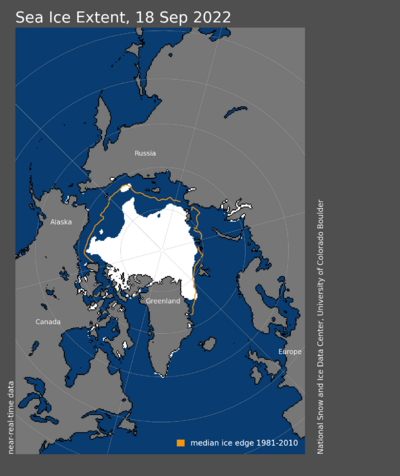
As you can see the amount of ice is considerably lower than the median. Higher temperatures in the Arctic means that more ice has melted. As can be seen in the next figure the amount of ice lost since 1979 is almost three million square kilometers - about the size of India.
2022 was the tenth low amount of ice at the minimum. The lowest amount was in 2012.
Ice sheets
- Unlike sea ice, ice sheets and glaciers are formed on land
- Ice sheets (>50,000 sq. km) are found in only two places: Greenland and Antarctica
The ice sheet in Greenland is of the most concern. Greenland's ice sheet is 1.7 million square kilometers in area and averages 2.3 kilometers deep. It holds 7% of the world's freshwater.
Greenland has been losing ice at a rate of 272 billion tons of ice per year since about 2000. Antarctica is losing 149 billion tons per year.
Glaciers
- Glaciers are found on all continents except Australia
- Glaciers are important as sources of freshwater. Many major rivers are feed by glaciers, and some countries rely on glacier melt for much of their water usage.
- Many glaciers are disappearing due to melting from global warming. Some areas may lose all of their glaciers.
Ocean Heat Content
The oceans have absorbed 90% of global warming. The top few meters of the ocean stores more heat than the atmosphere. Effects of this absorbed heat include:
- Thermal expansion of the oceans (see next section)
- Coral bleaching
- Melting of ice sheets
- Increased intensity of typhoons/hurricanes
The effects on oceans are often ignored. This video from NASA discusses how climate change affects the oceans
Sea level rise
The heating of water (above 4°C) causes the water to expand, this is called "thermal expansion". With the increased heat of the ocean, this implies that the oceans therefore will expand, This in turn increases the level of the sea.
Also, the melting of the land ice (ice sheets, glaciers, etc.) causes the amount of seawater to increase.[2]
Below shows the trend, Effects are discussed in the next section.
This article has some information about sea level rise. But the three videos on this page are the highlights (the first one is a bit more technical than the other two).
NASA's Sea Level Portal has up to date information on sea level changes
Freshwater and coastal systems
The combination of sea level rise, extreme weather, and changing climate has a number of effects on both freshwater systems and coastal regions.
- Changing precipitation and melting snow and ice affect water quantity and quality
- Sea level rise, along with extreme weather, will cause submerging, coastal flooding, and coastal erosion
- Many small island countries are especially vulnerable. Some islands may be submerged
Permafrost melting
Permafrost is soil which remains frozen all year.
Permafrost is usually found in soils with high organic matter. But because of the frozen soil the decay of organic matter occurs without air (anaerobic). Anaerobic decomposition produces methane, instead of carbon dioxide. This methane then get trapped in the soil, and this methane is then released when the permafrost melts.
Melting of permafrost is a feedback mechanism.
- Permafrost melting releases methane
- Methane is a greenhouse gas, increasing global warming. which increases global warming
- Increased temperatures cause more permafrost to melt, thus creating a loop
A very good video on permafrost and how climate change affects it can be found here
Ecosystems
Global warming can also affect wildlife, including:
- Shifting geographical ranges
- Changes in seasonal activities
- Changing migration patterns
- Changing species interactions
- Increased extinction rates
Social impacts
Golbal warming also has impacts on social issues:
- Increased health problems (heat-related problems, infectious diseases, etc.)
- example: Malaria-carrying mosquitoes cannot live in cold climates. Already we have see malaria further north than previously
- Displacement of people
- Risk of violent conflict
- Inequalities in development may be increased
Ocean Acidification
This effect is due to the carbon dioxide directly and not temperature change.
Carbon dioxide dissolves in the ocean to create acid conditions.
This in turn has an effect on marine organisms.
Calcium carbonate becomes more soluble as water becomes more acidic. Calcium carbonate is a major component of the shells of shellfish, the reef structure of hard corals, and in some plankton, such as diatoms.
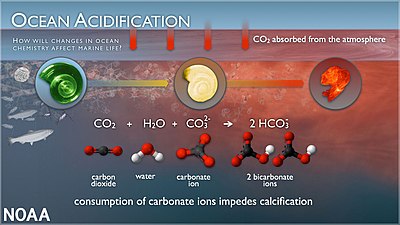
Mitigation
| Mitigation - Reducing the amount of greenhouse gases. Therefore, reducing the amount of global warming |
Background
- Previously, most international agreements were based on keeping warming to 2 °C above preindustrial levels
- Under the Paris Agreement, that was changed to 1.5 °C
- Warming reached 1.1 °C in 2022
- The Intergovernmental Panel on Climate Change (IPCC) Climate Change 2023 Synthesis Report states "This [human-caused climate change] has led to widespread adverse impacts and related losses and damages to nature and people."[ref 3]
- Analysis by the World Resources Institute (WRI) shows that to reach 1.5 °C target emissions must be reduced by 43% compared to 2019 levels by 2030 and 60% by 2035.[ref 4]
Principal method
- The most important methods were discussed under the Sustainable Energy section under Energy. Especially important are:
- Phasing out of fossil fuels
- Removal of fossil fuel subsidies
- Energy conservation
- Increased renewable energy
- Of these the most important is phasing out of fossil fuels. The IPCC has stated that complete phase out must be done by the year 2100 (with 80% renewable energy by 2050)[ref 5].
- Renewable energy and energy conservation are often called the "Twin Pillars" of sustainable energy.
Other methods for carbon reduction
- carbon tax - taxing companies for each ton of carbon dioxide they produce
- carbon markets (controversial) - trading carbon emissions on an open market (like a commodity market with carbon as the commodity). Problems have occurred due to corruption and mismanagement. Especially critical is the price of carbon.
Carbon removal
- Afforestation and reforestation.
- Bioenergy with carbon capture
- - Carbon capture (or sequestering) is capturing CO2 and then pumping it underground
- Soil sequestering
- Direct Air Capture
- Important to note these methods are unproven, except for reforestation. However, reforestation has not taken place at anywhere near the scale needed.
Agricultural practices (mostly nitrous oxide)
- Reduction in amount of nitrogen fertilizers used
- Conservation agriculture (no till, agroforestry, etc.)
- Livestock management
- Changing diets (especially in amount of meat consumed)
Land-use changes
- Ecosystem restoration
- Wetland management
- Prevention of destruction (especially drainage and fires) of peatlands
Geoengineering ???
- Geoengineering - mega projects to reduce effects of global warming
These are very controversial methods, which are probably not achievable.
- examples: setting huge mirrors in outer space, adding huge quantities of iron filings to the ocean, injecting aerosols of sulfur dioxide into the stratosphere
- problems: hugely expensive, most are not technically feasible with today's technology, may have undetermined consequences, and questions about governance
- note most of these do not address ocean acidification
Adaptation
As there are many, many ways to do adaptation; let us look at some examples:
Disaster reduction
- Building sea walls
- Prevent building in areas at risk of flooding and/or erosion
- Flood control
Food Security
- Changing crop types
- Drip irrigation
- Rainwater storage
Adaptation financing
- Generating a fund to help low income countries (the most talked about adaptation measure). The idea behind an "adaptation fund" is that rich countries create most of the greenhouse gas emissions, but the poor countries are affected the most by climate change. Therefore, rich countries pay into the fund, which is then used to pay for projects in poorer countries.
- An important adaptation fund is the Green Climate Fund.
- The World Resources Institute has many articles on adaptation financing
International Action on Climate Change
This section will talk about the major treaties and agreements as they relate to climate change.
United Nations Framework Convention on Climate Change (UNFCCC)
The United Nations Framework Convention on Climate Change (UNFCCC) was one of three conventions (treaties) agreed to at the 1992 Earth Summit in Rio de Janeiro, Brazil (the other ones were the Convention on Biodiversity and the Convention on Combating Desertification). It states that the signatories will work toward reducing emissions of greenhouse gases. Note that it, however, does not set targets or include any other mechanism for actually reducing greenhouse gases.
Each year the countries who have signed the treaty meet as the Conference of the Parties (COP).[3]
Intergovernmental Panel on Climate Change (IPCC)
The Intergovernmental Panel on Climate Change (IPCC) is a scientific body set up under the UNFCCC to review the information available on climate change. The IPCC does not do research or collect data, but instead reviews already published research and makes recommendations. The IPCC then writes an assessment report every five years. In addition, they may publish special report in between assessment reports.
Kyoto Protocol
As the UNFCCC does not contain any targets, the parties decided to set targets leading to the Kyoto Protocol in 1997.
The Kyoto Protocol required industrialized countries to reduce their greenhouse gas emissions (GHG) to specific target levels. Here an industrialized country is any of those listed as such within the treaty. Note that there were no targets set for developing countries.
There were some major problems with the Kyoto protocol:
- Some major GHG emitting countries did not ratify the treaty, most notably the United States - then the largest emitter of GHGs.
- China, then the second largest emitter, was classified as a developing country and as such had no target.
- Therefore, the two largest emitters had no reduction targets.
- There was no enforcement mechanism
The Kyoto Protocol expired in 2012.
Paris Agreement
As end of the Kyoto Protocol was approaching, there was much discussion of what to do, especially considering the ineffectiveness of the Kyoto Protocol. After extending the Kyoto Protocol for a couple of years, the parties agreed on the Paris Agreement at COP-21 in December, 2015.
The Paris Agreement uses a different approach. Instead of having set targets, it let individual countries set their own targets. Each country must submit a Nationally Determined Contribution (NDC) to the UNFCCC secretariat. This contains that country's target and how they plan to achieve that target. Note that countries must submit a NDC, but do that it is not legally binding.
| The following are the texts of the major treaties listed above:
The website of the IPCC is HERE. This includes the texts of all their reports |
Web Resources
| Here is a list of some websites on climate change. See also other sites/resources given in the above text.
Goddard Institute for Space Studies - data graphs and plots from the United States National Aeronautics and Space Administration (NASA) Scripps Institute of Oceanography - Home of the Keeling Curve National Snow and Ice Data Center - Up to date maps, graphs, and reports on ice in the Arctic (including Greenland), Antarctic, and glaciers |
Notes
- ↑ Note that CFC's are often given, but due to the Montreal Protocol they now account for less than 0.1% of all emissions
- ↑ Note that a common misconception is that most sea level rise is due to melting ice. In reality, over half of all increase is due to thermal expansion
- ↑ The term "Conference of the Parties" is a term of international law. Many treaties have one of these, even though not always annually.
Reference
- ↑ IPCC, 2022 Emission Trends and Driver. In: Climate Change: Contribution of Working Group III
- ↑ Scripps Institution of Oceanography, https://keelingcurve.ucsd.edu/, viewed on 12 April, 2023
- ↑ IPCC, 2023 Summary for Policymakers. In: Climate Change: Synthesis Report. Available at here
- ↑ World Resources Institute, "10 Big Findings from the 2023 IPCC Report on Climate Change", https://www.wri.org/insights/2023-ipcc-ar6-synthesis-report-climate-change-findings
- ↑ Fossil fuels should be phased out by 2100 says IPCC
